Top>Education>Sansanbito—Learning from the People of Minamisanriku, the Tsunami Disaster Area
 Index
Index
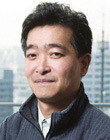
Masayoshi Tanishita [profile]
Sansanbito—Learning from the People of Minamisanriku, the Tsunami Disaster Area
Masayoshi Tanishita
Professor of Urban Engineering and Quantitative Spatial Analysis, Faculty of Science and Engineering, Chuo University
Introduction
The tsunami which struck Japan shook the very earth and annihilated all of civilization in the disaster area. Professor Tanishita teaches an FLP environmental seminar which seeks to discover and reevaluate local resources remaining in the disaster area, as well as promoting ecotourism which encourages environmental conservation and promotes development of the region and its tourism. From March 2012, students in the Tanishita FLP seminar conducted field activities in Minamisanriku Town, Miyagi Prefecture.
In Minamisanriku Town, we met fishermen who never spoke of any hatred for the tsunami. We encountered farmers who, while they would never brag of their work, produced delicious vegetables and processed food products. In order to maintain and rejuvenate this community which values nature and traditional culture, local people listened carefully to each other’s opinions and held patient discussions regarding difficult problems with conflicts of interests.
Students were deeply inspired through their repeated visits to Minamisanriku Town. Eventually, they went beyond the scope of seminar activities and established an organization named Sansanbito. This summer, they held the Minamisanriku Student Eco Tour. This article describes the passion which students put into Sansanbito and introduces the Student Eco Tour.
The Birth of Sansanbito
By Aoi Higuchi, 3rd-year student in the Faculty of Law
I first visited Minamisanriku in August 2012. At the time of my visit, 18 months had already passed since the Great East Japan Earthquake. The removal of rubble was almost finished. The surface of farmland and housing lots was covered in vast expanse of summer grass. The mountain regions of Minamisanriku had been spared the wrath of the tsunami and showed the same countryside scenes seen in any rural part of Japan. This was my first impression of Minamisanriku. At that time, I had no idea that I would be infatuated and develop a deep affection for Minamisanriku, and that I would establish the organization Sansanbito.
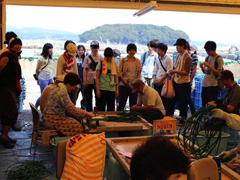
The turning point came in March 2013, during my 3rd visit to the town. That visit was the first time that I was able to recognize changes—although very subtle—in the appearance of Minamisanriku as the town which strove to rebuild. It was also the first time that I felt nostalgia upon meeting again with local people whom I often worked together with. More than anything, I felt great joy towards the townsfolk who welcomed students with the same hospitality as if greeting relatives. There is Katsuyoshi Abe, a local guide who always peppers his conversation with jokes. Other locals whom I formed a special relationship with were Taichi Yamauchi, who told me to visit anytime, and Tomiko Yamauchi, who always asked me when I could stay at her house. Upon my 3rd visit, I finally realized that many unique and warm people live in Minamisanriku. I felt as if it were my home away from home. From that point forward, I was gradually drawn in by the appeal of people in Minamisanriku. Before I realized it, I had visited the town 7 times!
Sansanbito was established from the desire to introduce the appeal of Minamisanriku to even more people. The phrase “sansan” can be found in many places throughout the town. For example, Sun Sun Shopping Village (temporary shopping area which opened in the Shizugawa neighborhood of Minamisanriku in February 2012) has a slogan of creating the Minami”san”riku shopping area to be filled with happiness and vitality, just like the sparkling sansan of the sun. There is also the School Building Boarding House Sansan, which is a learning/lodging facility created by remodeling a closed school building. The phrase bito means people in Japanese and refers to the charming people of Minamisanriku. What students who frequently visited Minamisanriku can do is to convey information on the town and promote its many attractive aspects. Our first step was to create an opportunity for students living in Tokyo to visit the town. Based on this idea, we planned the Minamisanriku Student Eco Tour which was held this summer.
Minamisanriku Student Eco Tour
By Yohei Koike, 3rd-year student in the Faculty of Economics

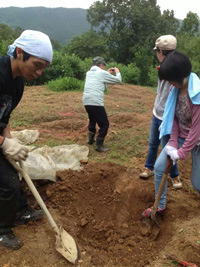
Our plan mainly targets students at Chuo University. We advertised the tour using leaflets (pictured at right) and Facebook. Ultimately, we were able to recruit 11 participants, including students from other universities. In order to convey the appeal of Minamisanriku and to increase participant’s affection towards the town, we took special note of the following two points. First, instead of focusing on activities for the tour, we focused on what kind of local people the participants could meet in Minamisanriku. Second, we wanted participants to become familiar with both the ocean and mountains of Minamisanriku. This environment is an easy-to-understand example of connection between forests, villages, rivers and the ocean, with all rain falling on the town flowing into Shizugawa Bay and Isatomae Bay.

On the first day of the 3 days and 2 nights tour, participants divided into two groups to help with thinning trees and transplanting blueberry bushes. The tree-thinning group was guided by local residents Katsuyoshi Abe and Masanori Sugahara, who taught participants the importance of tree-thinning and showed them how to cut trees using a chainsaw. The thunderous impact of falling trees was especially memorable for students. The blueberry-transplanting group was led by Taichi Yamauchi, who taught them the intricacies of cultivating berries and the many processed food products which can be made. On the morning of the second day, participants tried fishing and learned about the culturing of fish. Students listened as fishermen described how fast oysters and scallops grew after the tsunami, becoming ready for harvest in only one-third of the time. Afterward, students sampled some scallops at a restaurant named Hottate-goya. In the afternoon, students divided into two groups to help with mountain maintenance and volunteer at a facility called the Toy Library. Sansanbito staff members guided participants in performing mountain maintenance for the Peaceful Forest with Ocean View, which is located behind the Hotel Kanyo. During the tour, students slept at the home of Tomiko Yamauchi. They also had the opportunity to see bonfires used in the Hachimangawa-Kagari Festival which is held in the Sun Sun Shopping Village. They even saw fireworks which had been postponed due to rain. On the morning of the final day, Katsuyoshi Abe guided participants on a 2-hour walk through the mountainous Kamitaira district (see picture below). Katsuyoshi entertained students with his humor as he showed them the legendary giant stones of the mountain, took them to the largest home in the district, and even invited them into his own home. At Katsuyoshi’s home, students were treated to two types of corn picked from the fields outside. Participants also toured the pesticide-free rice field which Katsuyoshi started from this year.
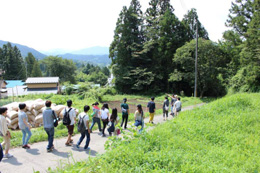
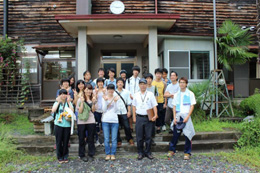
According to a follow-up questionnaire, almost all tour participants felt the appeal of Minamisanriku and wished to participate again in a student tour. Some students responded that they wanted to interact more with local people and even spend time living in the town.
However, there were also many problems with the tour which must be corrected in the future. For example, participants were not contacted in a timely manner and there was insufficient explanation regarding activities and places to be visited.
Currently, through the cooperation of local citizens, we are working to correct these problems as we plan the second edition of the Minamisanriku Student Eco Tour. We are also conducting other activities to convey the appeal of Minamisanriku to more people and to help with sustainable community-building. For example, we give a presentation at the Japan Ecotourism Society Symposium for Students and are conveying information via the internet.
Conclusion
By visiting Minamisanriku many times and repeatedly interacting with local citizens, students recognized broad environmental problems faced by the region. Normally, students study in the classroom or conduct limited activities in the community. However, in the Tanishita FLP seminar, students had a variety of experiences in the disaster area and were faced with problems whose answers cannot be found through a simple internet search. As a result, students encountered new values and were able to think with a wider perspective. I firmly believe that FLP seminar activities are also meaningful in preparing students to consider their future and search for employment.
Another feature of seminar activities in Minamisanriku is the support from alumni Hiroyasu Takamine (Faculty of Law), Shuichi Shiga (Faculty of Economics) and Sachie Saijo (Faculty of Commerce). Chuo University has yet to sufficiently utilize the power of alumni who are active in Japan and overseas. I sincerely hope that the future will bring an increasing range of fields for cooperation between alumni and current students. In order to realize such new learning opportunities, it is necessary to organize a system for faculty/administrative staff, to provide financial support in terms of transportation/lodging costs, and to develop a system for approval of academic credits.
In closing, I would like to express my deep gratitude for the cooperation received from many people in Minamisanriku Town. Special thanks go to the Minamisanriku-Cho Tourism Association and Mr. Suzuki of the Miyagi University Fukko Station.
Related URLs (Date of access is October 22nd, 2013 for all sites)
- Masayoshi Tanishita
Professor of Urban Engineering and Quantitative Spatial Analysis, Faculty of Science and Engineering, Chuo University - Professor Tanishita was born in Ishikawa Prefecture in 1967.
He withdrew from the Doctoral Course, School of Engineering, the University of Tokyo, in 1992.
He became a Professor in 2008, on the Faculty of Science and Engineering, Chuo University, after assuming the positions of Associate Researcher at the University of Tokyo, Full-Time Lecturer in School of Engineering, at the University of Tokyo, Full-Time Lecturer, Assistant Professor and Associate Professor on the Faculty of Science and Engineering, Chuo University.
Area of specialization: Urban Engineering, Quantitative Spatial Analysis
Current areas of research: the external costs of automobiles and related tax systems, effects of regional planning and building agreement on the real estate market, physiological evaluation of walking space, management organization of public space, and the like.
- Research Activities as a Member of Research Fellowship for Young Scientists (DC1), Japan Society for the Promotion of Science (JSPS) Shuma Tsurumi
- Important Factors for Innovation in Payment Services Nobuhiko Sugiura
- Beyond the Concepts of Fellow Citizens and Foreigners— To Achieve SDGs Goal 10 “Reduce Inequality Within and Among Countries” Rika Lee
- Diary of Struggles in Cambodia Fumie Fukuoka
- How Can We Measure Learning Ability?
—Analysis of a Competency Self-Assessment Questionnaire— Yu Saito / Yoko Neha - The Making of the Movie Kirakira Megane








